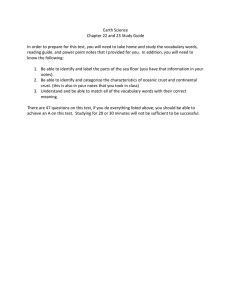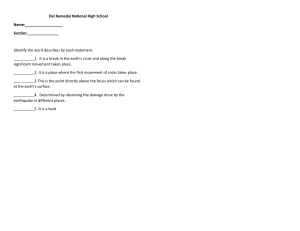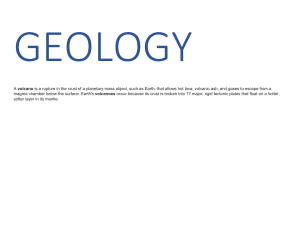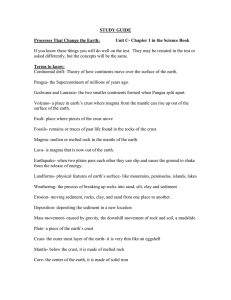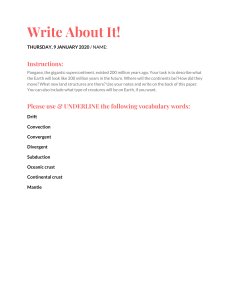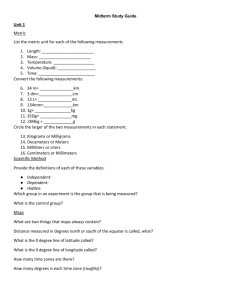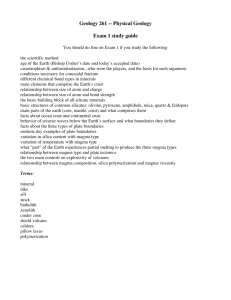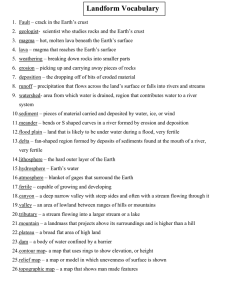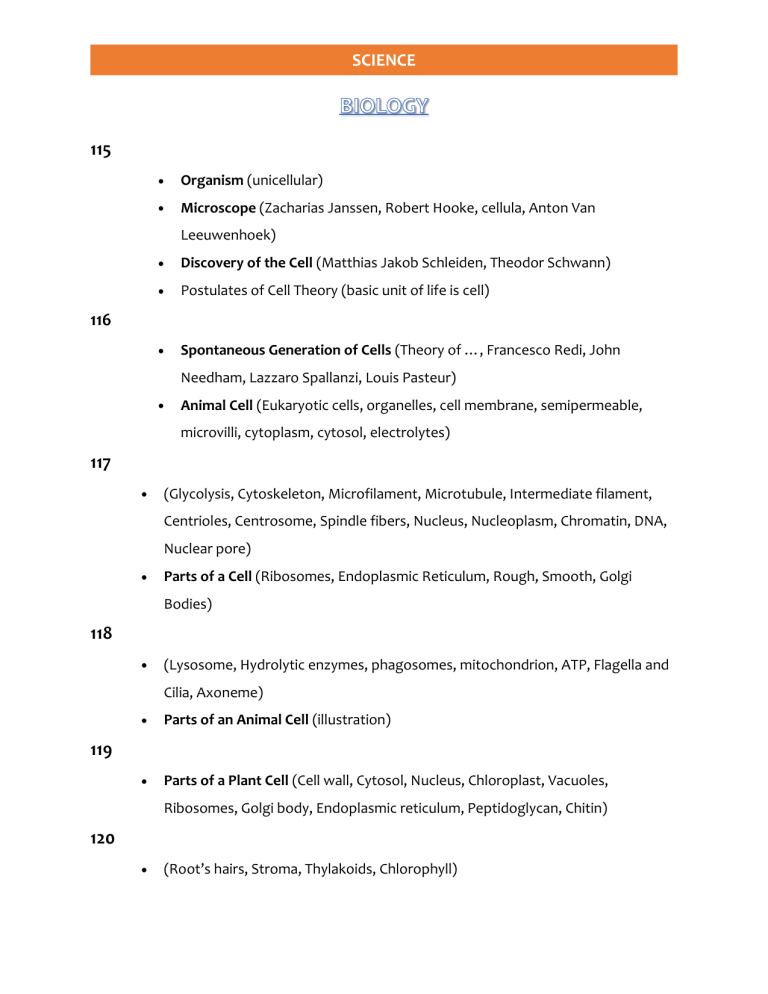
SCIENCE 115 • Organism (unicellular) • Microscope (Zacharias Janssen, Robert Hooke, cellula, Anton Van Leeuwenhoek) • Discovery of the Cell (Matthias Jakob Schleiden, Theodor Schwann) • Postulates of Cell Theory (basic unit of life is cell) • Spontaneous Generation of Cells (Theory of …, Francesco Redi, John 116 Needham, Lazzaro Spallanzi, Louis Pasteur) • Animal Cell (Eukaryotic cells, organelles, cell membrane, semipermeable, microvilli, cytoplasm, cytosol, electrolytes) 117 • (Glycolysis, Cytoskeleton, Microfilament, Microtubule, Intermediate filament, Centrioles, Centrosome, Spindle fibers, Nucleus, Nucleoplasm, Chromatin, DNA, Nuclear pore) • Parts of a Cell (Ribosomes, Endoplasmic Reticulum, Rough, Smooth, Golgi Bodies) 118 • (Lysosome, Hydrolytic enzymes, phagosomes, mitochondrion, ATP, Flagella and Cilia, Axoneme) • Parts of an Animal Cell (illustration) • Parts of a Plant Cell (Cell wall, Cytosol, Nucleus, Chloroplast, Vacuoles, 119 Ribosomes, Golgi body, Endoplasmic reticulum, Peptidoglycan, Chitin) 120 • (Root’s hairs, Stroma, Thylakoids, Chlorophyll) SCIENCE • Vacuole (Plant cell's, Animal cell's, Biological system requires buffers; is a group of organs, Metabolic reactions, Phospholipids) • Two Kinds of Transport Mechanisms (Active and Passive Transport, Osmosis, Diffusion) 121 • (Facilitated diffusion, Concentration, Carrier changes shape) • Two Faces of Golgi Body (Cis face, Trans face, Fluid Mosaic model, Seymour Jonathan Singer and Garth L. Nicolson; published a paper) • Phospholipid (Head phosphate, tail lipids, RBC Glycolipids, Rhesus factor) • (Agglutination, O Rh D negative, AB Rh D positive, Blood Donation Chart) • Blood Types and Personalities (Type A, B, AB, O) • Two Types of Cellular Respiration (Turgid, increase the rate of Photosynthesis, 122 Aerobic, Anaerobic) • Three Stages of Aerobic Respiration (Glycolysis, Citric Acid Cycle, Electron Transport Chain, Transcription, base sequence of DNA; RNA, Eukaryotic cells, Prokaryotes, Hierarchy of organisms) 123 • Three Domains of Life (Archaea, Bacteria, Eukarya, Robert Whittaker; five-kingdom scheme, Plantae) 124 • (Gymnosperms, Angiosperms, Bryophytes, Pteridophytes, Phylum, Animalia, Fungi, Protista, Monera, Viruses, Vascular tissues, ) • (Cilia, Echinoderms, Gibberellins) • Parts of a Flower 125 126 SCIENCE • Parts of a Heart • Respiratory System • (Oogenesis, Spermatogenesis, Tubular Secretion, Filtration, Selective 127 128 reabsorption, Coevolution, Genetic drift, Stabilizing and Convergent evolution, Unicellular heterotrophs, Asexual reproduction) • Biomes (Taiga) • (Tundra, Deciduous Forest, Five Levels of the Biosphere) • Cell Cycle (interphase, Centromere, Centrosome, Gap 1, Synthesis phase, Gap 2) • Mitosis (Prophase, Metaphase, Anaphase, Telophase, Cytokinesis) • Meiosis (Interphase, Prophase I, Metaphase I, Anaphase I, Telophase I and 129 130 Cytokinesis) 131 • Molecular Composition of Cells (biomolecules, Carbohydrates, Monosaccharides, Aldose, Ketose, Disaccharides, Sucrose, Lactose, Maltose, Polysaccharides, Lactase, Pectin, Lipids, Triglycerides, Fatty acids, Dehydration synthesis, Steroids, Atherosclerosis) 132 • (Waxes, Hydrocortisone) • Sex Hormones and Acids (Testosterone, Estrogen, Proteins, Myosin and actin, Collagen, Amino acid) • Scientific Name of Some Animals SCIENCE 133 • LIFE, ENERGY, AND THE ENVIRONMENT (Living things, food web, protons and neutrons,) 134 • (Radiant, Electrons, Electric current, Energy, Potential, Kinetic, Thermal, Electrical, Chemical, Nuclear, Work Done, Resistance, Current, Voltage, Insulators) 135 • (The Ohm, Ampere or amp, Volt, Watt, Electric Field, Temperature, Crust, Fossils, Climate, Acid Rain, Condensation, Evaporation) 136 • (Heat Energy, Pharynx, Larynx, Density, Loam, Mineral) 137 • (Fault, Seismic waves, Primary, Secondary, Love Waves, Seismograph, Richter Scale, Tidal wave, Ovary, Ovules, Gills, Parallel Circuit) 138 • White Light • Fr. Georges Lemaitre • Humidity; Typhoon • nebular hypothesis: Nebula • Emphysema • Planetesimal • Capillaries • Immanuel Kant and Simon Laplace • Eardrum • Thomas Chamberlin and Forest Ray • Pericardium • Big Bang Theory Moulton • Tidal Theory SCIENCE 139 • James H. Jeans and Harold Jeffrey • Protoplanet Theory – nebula ceased to rotate • Rene Descartes – Theory of Vortices • Stellar Collision Theory – collision of stars • Planetary Collision Theory – collided with a small planet • Accretion Theory – small chunks formed themselves • Capture Theory – Planets were captured by the gravity • Fission Theory – sun burst one day • Interface – interaction of Earth’s material and Sun • Accretion – particles clumping together • Fusion – increasing temperature and pressure • Fission – action of dividing or splitting • Nucleosynthesis – formation of new atomic nuclei • Cosmic microwave background – radiation from all parts of the sky; evidence for Big Bang theory; Penzias and Wilson in 1964. 140 • Doppler Effect – how fast stars and astronomical objects move • Redshift – track the rotation of our galaxy • Solar wind – continuous flow of charged particles • Jovian planets – group of four planets in the solar system • Jupiter have 79 known moons • Terrestrial planets, telluric planets, or rocky planet – planet composed of silicate rocks or metals • Oort Cloud – extended shell of icy objects; Jan Oort • Kuiper belt – region of the solar system beyond the orbit of Neptune • Properties of Minerals – up to page 142 SCIENCE 143 • Magnetism • Tenacity • Solubility Property of the Mineral • Acid reaction, feel, presence of • Cations and anions • Crystalline Structure of a Mineral • Laurasia • Microcrystalline and • Tethys • Alexander Du Toit – owner of the striations cryptocrystalline 144 • Gondwana • Process of Comminution • Concentration • Continental Drift • Atlantic Ocean • Origin of Continents and Oceans • Alfred Wegener • Harold Jeffrey – opponent on Divergent, Convergent, and Wegener’s theory Transform Plate Boundaries map • Thin oceanic crust and Thick continental crust • Continental Crust and Oceanic Crust • Kinds of plate tectonic boundaries: 145 • Divergent Plate Boundary – move • away from each other • Subduction zone – where plates meet Convergent Boundary – move • Oceanic crust meets oceanic toward one another • Oceanic crust meets continental Transform fault – slide pass each • Continental crust meets oceanic other • Plates • Compressive stress – convergent • Kinds of Plates – Major: greater • Tensional stress – divergent • Shear stress – transform • African Rift Valley – tension in • divergent plate than 20 million km squared, Minor: Less than 20m but greater than 1m km squared SCIENCE 146 • Major and Minor Plates • Plutonism – formation of extrusive igneous rock • Types of Rocks – Igneous, Sedimentary, Metamorphic • Magma, Lava • Weathering • Three types of weathering – Physical or mechanical 147 • Three types of weathering – Chemical, Biotic weathering • Three types of Physical weathering – Block disintegration, Exfoliation, Frost Action • Four types of Chemical weathering – Oxidation, Hydration, Solution, Carbonation • Types of Biotic weathering – Plant roots, burrowing, Human Being, Erosion, Lithification, Metamorphic Rocks, Aphanite, Phanerite • Types of Faults 148 • Reverse Fault – hanging wall rises • relative to the footwall • Normal fault – hanging wall has another • moved downward • • Transform fault – slide past one Strike-slip fault – moved horizontally Graben fault – depressed block of • Deformation the Earth’s crust • Elasticity Horst fault – raised block of the Earth’s crust 149 • Types of Folds – Monocline, Anticline, Syncline, Recumbent, Chevron, Isoclinal, Plunging, Domes, Ptygmatic fold • Volcanism; Volcano • Parts of a Volcano – Magma, Parasitic Cone, Sill, Vent, Flank, Lava.... SCIENCE 150 • Crater, Conduit, Pyroclastic Materials, Throat, Ash, Ash Cloud, Caldera • Three types of Volcanoes – Active, Dormant, Extinct • Four Principal Types of Volcanoes – Shield: shield in the middle with long gentle slopes, Composite: conical volcano built with many layers (strata), Cinder: circular or oval cones • Lava domes; Fissure • Two Types of explosion – Quiet; small amount of silica, Explosive: release in silica and pyroclastic materials • Magma and the Three Products of Eruption – Gasses and Vapors • Pyroclastic Materials, Volcanic 151 • ashes, Intrusive and Extrusive rocks Basaltic magma: low in silica; higher melting point • Processes that form Magma • • Environments of Magma Formation • Mantle Plume • Hotspot • Factors that Affect the • Coal Characteristics of Magma – • Fossil Fuels, Natural Gas, Coal and Granitic magma – high in silica; low melting point Oil 152 • Geothermal energy – heat from the earth • Permeability – allowing liquids, gases to pass thru • Porous Rocks – small holes • Geothermal Reservoir – natural collection of hot water • Hot Spring/Geyser – geothermal energy that reached the surface • Three types of Geothermal Power Plant – Dry Steam: oldest, Flash plants: placing hot into cooler water, Binary plants: placing hot water to a secondary fluid producing vapor • Hydroelectric energy SCIENCE • Dam; Intake system – where engrs control the water; Spillway – connecting dam to river • Nuclear energy • Fossil fuel combustion • Earth’s water is part of hydrosphere • 4 great oceans • Four Properties of Water – Cohesion, Adhesion.... • Surface Tension, Capillarity, • Transpiration; Crop rotation Groundwater • Green building Geological Formation of Ground • Mono-cropping; No till planting; 153 • water – Aquifers: can hold and • No-till Farming transmit, Aquitards: cannot hold • Soil conservation and transmit water • Cover crop Surface water; Spring; Infiltration, Runoff 154 • Five Factors that Affect Soil Transported, Cumulose, Soil, formation – Parent material, Gravel, Soil profile Climate, Topography, Biological • • Horizons of Soil – Humus or Factors, Time organic, Topsoil, Subsoil, Parent Broad Classification of Soil Parent material, Bedrock Material – Residual or sedentary, 155 • Four Kinds of Soil – Alluvial, cropping, Terracing, Waterways, Volcanic, Shale and Sandstone, Windbreak Limestone • Conservation and Protection of Soil – Contour farming, Strip • Waste Management – Solid Waste, Tailing, Mining waste sources SCIENCE • Agricultural waste, Industrial waste, Municipal waste 156 • • Waste Disposal Methods – Landfill, • Mass wasting – Sliding, Slumping Incineration, Mulch and Compost, movement, Rockfalls, Talus, Source reduction, Recycling Rockslides, Debris flows, Earthflow Two Geomorphic Processes – Exogenic: driven by gravity, Endogenic: located within the Earth 157 • Mudflow, Creep – slow, gradual • movement of soil, Slump – moved as a unit along a curved surface • Biosphere • energy • Earth’s time rotation – 23 hours, 56 minutes and 4.0916 seconds Subsystems of Earth – Lithosphere, Hydrosphere, Atmosphere, Sidereal day; Solar day; Solar • Melanin; Weather; Climate; 365.25 days Earth’s Revolution and Rotation 158 • Natural Gas is a hydrocarbon • Steam Coal • Carbon forms Diamond and Coal found in organisms • Grades of Coal – Lignite: lowest in the coal family, Sub Bituminous: more heat than lignite, Bituminous: soft coal, Anthracite: hardest coal and great amount of heat • Layers of Earth – Inner Core, Outer Core, Mantle, Crust • Dr. Inge Lehmann; Lehmann Discontinuity: abrupt increase of P-wave and S-wave velocities • Beno Gutenberg; Gutenberg Discontinuity – separates mantle from outer core • Mohorovicic Discontinuity or “Moho” – boundary between crust and mantle SCIENCE 159 • Andrija Mohorovicic • 80% radioactive decay, 20% leftover FeCr2O4. Belonging to the spinel heat from the Earth’s formation group • Magmatism – activity of magma • Fluidity of magma – due to high temperature and low pressure • • Chromite – iron chromium oxide: Inclusion – pieces of rocks contained within another • Intrusion – process of forcing a • Tension body of igneous rock between • Pointers on Geology – existing formations • Law of Cross-cutting relations – • • • cut is much younger, two groups of unconformable Law of Original Horizontality – strata layers of sediment were horizontal, • Geology – study of nonliving things Law of Superposition – youngest • Index fossils – identify geologic periods or faunal stages on top and oldest on bottom • • Unconformity – contact between Bauxite – not a mineral. One of • Risks and Hazards aluminum • Areas around Volcanoes • Thunderstorm – with thunder and Chalcocite – important copper one mineral. 160 • Downburst – very fast and vertically dropping blast of wind lightning • Tornado – violently rotating winds • Hail – pellets of frozen rain • Cyclone – system of winds rotating • Storm Surge – rising of the sea inward to an area of low • Fire triangles – simple model for • • Monsoon – due to reversing wind directions atmospheric pressure understanding the ingredients for Hurricane – storm with a violent most fires; illustrates the 3 wind elements a fire needs to ignite: SCIENCE heat, fuel, and an oxidizing agent • Five Types of Hazards – Physical, (usually oxygen) Chemical, Biological, Psychological, • Preparedness Aspects Radiation • National Disaster Risk Reduction & • • • Theory of Uniformitarianism – Management Council (NDRRMC) work today had been working in Hazard – threat to life, health, the past and will continue in the environment or property future. Disaster – event of serious destruction 161 • Four Key Elements of Disaster Preparedness – Preparedness, Response, Recovery, Mitigation • Four Layers of the Atmosphere – Troposphere: lowest layer, Stratosphere: From the top of the tropo to about 50km, Mesosphere: extends upward up to 85km, Thermosphere: Absorbs high energy X-rays and UV radiation from the sun • Composition of Atmosphere: Nitrogen (78%) Oxygen (21%) Argon (0.9%) Mixture of Carbon Dioxide, vapor, and other gases (0.1%) • Water Vapor – produced from the evaporation or boiling of liquid water 162 • Heat Transfer • Three methods – Conduction in • Altitude increase, air pressure will decrease solids, Convection of fluids (liquid or • Wind gases), Radiation through anything • Three Factors Which Cause the Air that will allow to Move – Pressure Gradient Force, • Air Pressure – force of air Coriolis effect, Friction of the • Density – as density increases, air ground and molecules pressure will also increase SCIENCE 163 • Global and Local Wind Pattern • Global winds – large air masses created mainly as a result of the Earth’s rotation • Sea breezes and Land breezes – higher pressure over the water to lower pressure over the land causing the sea breeze. At night, the roles reverse. • Mountain and Valley breezes – similar to sea and land • Wind Systems in the Philippines • Northeast Monsoon (Amihan) – Dec to middle of Feb; cold • Southwest Monsoon (Habagat) – March to Nov; Warm humid season • Humidity – amount of water vapor in the air • Amount of water vapor – can hold depends on the temperature • Warm air carries more moisture • Relative Humidity – amount of water vapor expressed as a percentage of the amount • Transpiration – loss of water vapor along the surface of the plant 164 • Branches of Chemistry – • Analytical – quantification and identification of chemical substances or analytes. • Physical – deals with the physical properties of chemical substances using Physics • Organic – deal with carbon compounds. • Inorganic – deals with compounds without C and H. • Biochemistry – chemical reactions within living things. • Three States of Matter – Solid: definite shape, Liquid: conforms to shape of container, Gas: occupies the whole space • Properties of Matter – Physical and Chemical • Chemical Classification of Matter – Mixtures and Pure Substances • Homogenous: singular characteristic and Heterogenous: multiple characteristic SCIENCE • Pure substances – with fixed chemical composition • Elements – cannot be broken down • Compounds – two or more elements bounded together • Law of Chemical Combinations – • Law of Mass Conservation – total mass of substances combined does not change and thus conserved • Law of Definite Proportions – a chemical compound is always made up of same elements • Law of Multiple Proportions – when two elements are combined, fixed masses can be expressed as simple ratio 165 • Significant Figures • The Atomic Models 166 • Periodic Table of Elements 167 • Chemistry Formulas (Ideal Gas Law, Charle’s Law, Avogadro’s Law, Molarity, Concentration, Boyle’s Law, Gay-Lussac’s Law, Combined Gas Law, Molality, Pressure) • Physical Quantity • 7 Fundamental Quantities – Length, Time, Mass, Temperature, Electric Current, Amount of Substance, Luminous Intensity • Prefixes for SI Units 168 • Scalars – describes the magnitude of an object • Vectors – magnitude and direction of an object • The ∆ Symbol – Delta; change of variable SCIENCE • Motion • Distance: total length of the route travelled vs. Displacement: distance from initial position to the final position of an object • Average Velocity: average of the initial and final velocities vs. Instantaneous Velocity: exact velocity at a certain time • Average Acceleration vs. Instantaneous Acceleration • 4 Kinematic Equations – useful for finding either the displacement, initial velocity, final velocity, acceleration, or time. 169 • Free fall • Projectile Motion • Force • Types of Forces: Contact Forces, Action-at-a-Distance Forces • Mass vs. Weight 170 • Equilibrium • Inertia • Newton’s First Law of Motion (Law • Free Body Diagram (FBD) of Inertia) • Friction Newton’s Second Law of Motion • Kinetic friction • Centripetal Force – inward force; • • Newton’s Third Law of Motion (Law of Interaction) (Law of Acceleration) 171 • Static Friction • Uniform Circular Motion • Centripetal Acceleration (Radial • Gravitation Acceleration) – Inward • Law of Universal Gravitation acceleration applied to a moving object Centrifugal Force – outward force (Gravitational Force) SCIENCE 172 • Acceleration due to Gravity • Escape Speed • Closed orbits: Circular, Elliptic vs. Open orbits: Paraboloid, Hyperboloid • Orbital Speed; Orbital Period • Kepler’s 1st Law (Law of Orbits) • Kepler’s 2nd Law (Law of Areas) • Kepler’s 3rd Law (Law of Periods) • Perihelion: Earth’s orbit is nearest to the sun • Aphelion: Earth’s orbit is farthest to the sun 173 174 • Work, Energy, and Power • Work – is scalar quantity expressed • • Types of Kinetic Energy: Sound, Radiant, Thermal, Electrical in Joules (J) • Work-Energy Theorem Energy – Quantitative property • Hooke’s Law – compute the Force found in objects; ability to do work exerted by a spring to an object • Kinetic Energy – energy of motion • • Work in a Force x Displacement Graph – the total work done on an object is equal to Work done by a Spring 175 the area below the graph • Potential energy – energy stored in an object due to its position • Types of Potential energy – Gravitational Potential, Elastic Potential, Nuclear, Chemical PHYSICS FORMULAS • Density • Strain • Voltage • Pressure • Buoyancy • Snell’s Law • Stress • Torque • Index of refraction • Velocity of a wave SCIENCE
